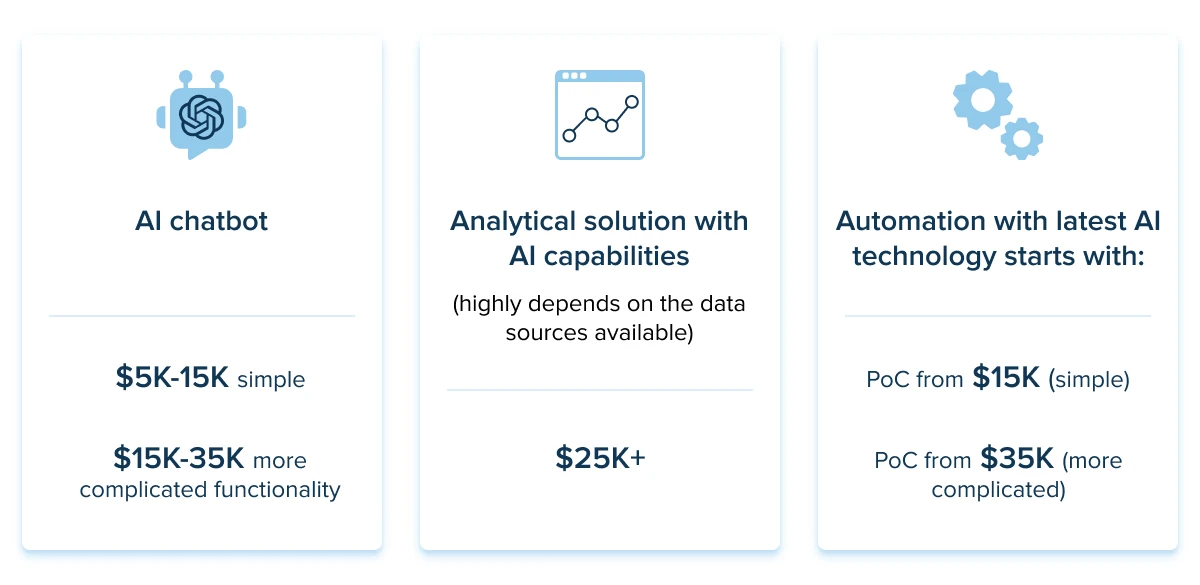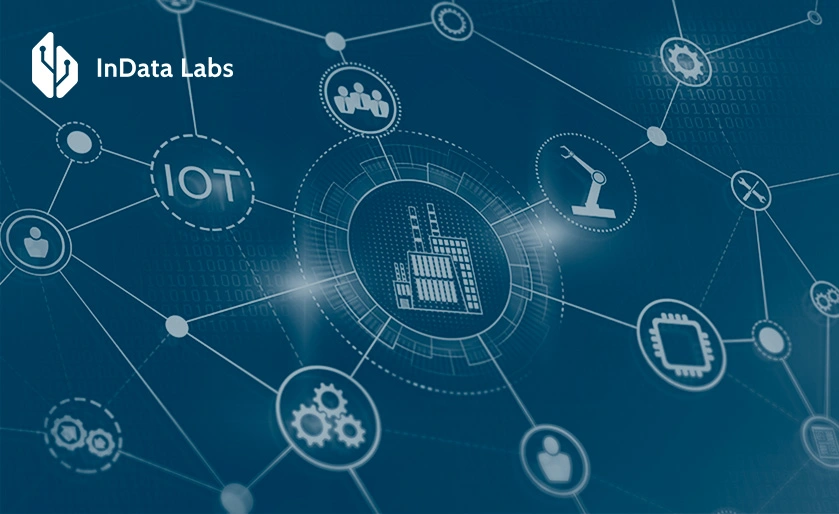Total global investment in AI systems has already reached $184,00 billion and counting. With that in mind, a growing number of businesses start to look into the cost of implementing AI.
However, AI pricing has no definite answer. The total cost of AI development and maintaining a bespoke intelligence system is led by a number of variables. Therefore, AI project costs are estimated individually.
This article aims to shed light on the main cost drivers. We’ll also provide ballpark estimates so that you can get a general idea of AI pricing.
Why do businesses invest in artificial intelligence?
In 2025, waiting can be expensive. With the turbulence in the business environment, the need for automation is more acute than ever. Thus, global companies are turning to greater use of smart systems to ensure business resilience in whatever circumstances. From in-house delegation to customer service, artificial intelligence has the greatest potential to automate workflows, leading to significant cost reduction.
Besides this most apparent advantage, smart applications let us reap the following benefits:
- Effective data management
Artificial intelligence allows organizations to make the most of the incoming data. For example, AI technology can monitor the condition of the equipment. It reduces the risk of damage or sudden breakdowns. - Reducing manual input
By automating business processes, companies speed up business processes. Compared with manual processing, AI performs complex tasks faster and more efficiently. Thus, you can automate sending emails, booking airline tickets, and other mundane tasks. - Predictive analytics
AI-enabled systems allow businesses to uncover hidden patterns and dependencies. This, in turn, results in the more effective use of Big data and forecasting ability. Predictive analytics can also promote cross-sell opportunities, forecast inventory, and improve daily operations. - Security maintenance
With tons of records exposed in the US every year, adequate security infrastructure remains a burning issue. Luckily, AI systems can assist companies in discovering malpractices and fraudulent transactions. This side of artificial intelligence is particularly interesting for businesses that develop fully automatic systems or handle highly sensitive information.

Source: Unsplash
Common challenges in implementing artificial intelligence
The cost of AI implementation is greatly influenced by the complexity of automated systems. Thus, materializing an AI strategy that aligns with current business objectives goes hand in hand with some challenges. Let’s have a look at some of them.
- Inaccurate data
Most AI solutions feed on quality data. They are pulling every data input and drilling into those inputs to generate new rules for business intelligence. Hence, the process of AI implementation always includes the use of the right data set with complete information.
Whether it’s labeled or unlabeled data or search logs, companies need to obtain a good data store in place for data scientists to produce models. However, identifying the right set of data is challenging. Especially if a company has all kinds of information floating around.With that in mind, most organizations contact AI professionals. The latter walk them through the right path and method to pinpoint the suitable data fuel. - Data security and storage
Smart infrastructure detects vulnerabilities. However, it can also create an additional surface for cyber-attacks and data leaks because of the significant amounts of data analyzed. A huge amount of data can also trigger a storage issue for businesses. Data-driven automation in business operations may cause issues related to data security.
Source: Unsplash
Therefore, companies need to implement a data management environment. The latter will guarantee supreme security to vulnerabilities and simple access to data for AI projects.
- AI integration into internal systems
Most often, established businesses are the ones that seek AI adoption. However, companies struggle to integrate AI into existing business systems. This bottleneck stems from the need to collect, clean up, and create a single representation of data. This range of tasks results in many integration use cases, such as data integration and increasing usability. AI integration often makes up a large part of AI pricing since the vendor takes over a full suite of processes from conception to deployment. - Sophisticated algorithms and training
The performance of your AI infrastructure rests on the accuracy of intelligent algorithms. However, it requires a lot of time and data to train a model. The latter also needs to be deployed in production so that your business intelligence can make forecasts in the real world. Moreover, AI-based algorithms require continuous training and relevant data to maintain the level of accuracy. That is why maintenance of AI projects is another expenditure item you need to factor in.
How much does artificial intelligence cost? Main cost drivers
Just like any other tech project, AI development cost sits on the basic estimation fundamentals. Further, cost-effective AI pricing is an adaptation and evolution from that. In particular, four key aspects impact one’s project estimation. These include:
- The cooperation model (outsourcing, in-house development, and others)
- Project management triangle (time, cost, scope)
- Core features of your future smart solution
- Project complexity.
Custom AI pricing is higher by default. To build a bespoke solution, programmers and software experts have to create the entire system from scratch. Off-the-shelf solutions are less expensive, although they cannot guarantee an exact match with your business requirements.

Source: Unsplash
Whereas the cooperation model and project management triangle go for any IT development process, we’ll focus on AI-specific subtleties of your project. In general, it goes into the project complexity category. So, here’s what drives up the costs of artificial intelligence.
Artificial intelligence cost estimation in brief
At InData Labs, we’ve defined the cost of implementing AI depending on the complexity:

And now, let’s go into greater detail on artificial intelligence cost estimation:
Cost driver #1: Data complexity
Intelligent functionality and data go hand in hand. Therefore, to construct a reliable training algorithm model, the development team needs to feed huge amounts of data into the system. The bigger the dataset, the more accurate the algorithm will become.
Also, data-laden algorithms can unearth hidden relationships between inputs and outputs faster. Hence, AI professionals can face one of the three challenges when developing your project.
Lack of quality data
Your internal data resources may not be enough to generate all the data needed to train the model. Therefore, your tech supplier will have to scour third-party data sources. This results in more time and manual input.
Complex ETL process
ETL is known as an Extract, Transform, and Load procedure. It pulls and adds data from multiple sources to a unified data repository. It is necessary when your development team deals with lots of disconnected data points to compile all the data.
Unstructured data
The structure of the data is another pricing factor in AI implementation. Whereas structured information poses no difficulty, unstructured data is harder to manage. Therefore, your technical vendor must sort, manage, and organize the data before including it into the model.

Source: Unsplash
On the other hand, you may get away with unstructured or semi-structured input. In this case, developers apply advanced machine learning algorithms. The latter targets this specific type of data and builds up AI costs as well.
Cost driver #2: Algorithm performance
You can’t implement an AI solution without devising a data-enabled algorithm. That is why algorithms are another critical factor that affects overall AI development. In particular, the accuracy rate of the algorithm is where the tech budget gets higher or lower.
For example, if you’re looking to build a face recognition system, this software should have near-perfect accuracy. Thus, verification algorithms that match subjects to database images achieve accuracy scores as high as 99.97%.
Some applications may allow a wider margin of error, hence accuracy may vary for different applications. But a higher precision rate will inevitably incur higher costs of artificial intelligence.

Source: Unsplash
These factors are some of the essential ones that go with the cost of artificial intelligence. The type of software you want to build affects the cost as well. Custom feature-rich solutions are more time-consuming, directly leading to higher costs. Integrating a ready-made SDK/API is less labor intensive.
AI implementation cost breakdown by project stage
Being a complex technical solution, any smart system needs to be built gradually. It means that the implementation process falls into multiple stages. Each development phase guzzles up manual and financial resources. Therefore, it is important to know how to price an AI project during each development stage. Especially if you’re hiring a third-party vendor to take over a specific segment of software creation.
The timeline and sequence of the development stages can vary based on the scope and the requirements for artificial intelligence you want to enrich your product with.
Feasibility study
In many cases, AI projects require certain R&D activities to identify the best delivery approach. It usually holds true for custom software development. In this case, there is hardly any straightforward way to deliver the project, unlike off-the-shelf software development projects.

Source: Unsplash
The client has to be ready to kick-off AI implementation with a Discovery stage or a PoC. In over 90% of cases, this entails a budget of $20-30k to deliver the initial piece (PoC/Discovery). This part of the process is of utmost importance. It allows the client to validate an idea at an early stage and catch a better view of the solution or product, mitigating risks of the project’s failure and saving the budget.
For the development team, this stage is essential to identify the technical approach and find the most optimal solution to the problem in terms of the further cost involved.
Also, a feasibility study helps the vendor make sure the client has all the data needed. AI projects can fail if the data is incomplete or hard to obtain. Once the data is present the actual implementation is likely to become the easiest part.
Results of this development stage include:

Problem analysis
The development process starts with a thorough analysis of your business needs. The main goal of this stage is to make sure that the project goals and the technical capabilities of ML engineers align.
Also, it’s this stage that requires stakeholders to articulate the business problem. The more specific you are about this, the more successful your implementation will be. The applications for intelligent systems usually revolve around attainable goals that amplify the company and support end-users of the software.
How much does artificial intelligence cost at this stage? It differs. Some problems are better off without Machine Learning so the company opts for another solution. Sometimes a company just needs professional advice on the data required for the algorithm.
In-depth business analysis is also essential to help engineers get a better idea of the project mission. With a clear goal in mind, developers can match business requirements with the most optimum technical solutions.
The result is detailed functional and nonfunctional requirements to AI. They include the accuracy rate of the solution, explainability, fairness, privacy, and response time. To learn more about data analytics and AI integration, please watch a video:
Architecture design
This stage duration depends on the general complexity of the software. Overall, solution architecture is a complex process. It bridges the gap between business problems and technology solutions.

Source: Unsplash
In particular, it involves identifying a suitable tech solution to address the specific business problem. This stage also helps to describe the structure, characteristics, behavior, and other components to stakeholders. Finally, architecture design is important to choose integration patterns and procedures.
Software development
This stage of the software lifecycle is the most labor-intensive. Within AI implementation, this part can be divided into two phases. The first phase is not related to artificial intelligence. There, developers set up the front end and the back end of software and integrate APIs for AI modules. Once the software is successfully tested, the development team can go over the actual development of a smart system.
AI module development
This development stage mainly has to do with preparing data for a machine learning algorithm. Data-related tasks are usually among the most time-consuming, contributing to higher AI costs. Once ML engineers have access to the databases, they make sure the client has enough data for the project. If it is tabular data, it gets visualized for the sake of convenience.
Moreover, data scientists often have to cleanse data. It means that all input must be standardized and duplicate-free. If the client processes sensitive data, the latter must be anonymized.
Data collection [optional]
The best-case scenario is when a business has enough in-house data to train the model. But if you lack the necessary data for your project or it lacks diversity, the team will have to collect additional input.
Another issue is the raw type of data, i.e. data with no or little markup. In this case, the Project Manager will have to assign additional team members to get enough markup.
Creating a baseline model
Once the data scientists have collected all necessary data, they create a baseline model as a starting point. A baseline model is both simple to set up and effective to get decent results. Experimenting with them is also quick and low cost.
Also, baselines help engineers to predict the accuracy of a more complex model. Once the quality of the model seems satisfying, the development team goes over to creating a more advanced ML model.
Prototyping and Minimum Viable Products are also common to further validate the solution. Thus, prototyping allows the team to test hypotheses about potential solutions by analyzing collected data.

Source: Unsplash
Viable hypotheses are then used to build the first version of the product to be launched, i.e. MVP. Once launched, MVP will generate new data through interactions with users. This feedback helps improve the quantitative or qualitative characteristics of the product.
ML model training
This stage takes up several weeks based on the model complexity. During this stage, ML engineers select suitable ML algorithms and build ML models. The models then have to be trained with training data and tested against a sample dataset. Engineers validate the final model against a test dataset in the pre-production environment.
Deployment
Finally, the solution reaches the state of equilibrium, i.e. is ready to be deployed. Vendors often perform pilot deployment to a test group of users to make sure the deployment is friction-free. The pilot deployment also helps verify the compatibility with the infrastructure and perform user acceptance testing to eliminate issues before going in full gear.
Maintenance
Software support is as important as software development. Therefore, you should factor in maintenance into the AI costs as well. The development team will monitor the quality of the existing solution. Adaptation and retraining of AI components are often common due to the new data accumulated by the product.

Source: Unsplash
Marketing AI pricing is something you need to consider when building a smart solution for the public.
How much does artificial intelligence cost in 2025 and beyond?
Now that we went over the basics of the AI development process, it’s clear that each stage requires financial resources. But the key point you should consider while thinking about AI implementation to your business is that your project will start with the Investigation stage with the cost of $20K-30K which will guarantee the scalability of your project and provide you with the detailed estimation of the project’s duration and cost.

Almost every industrial sector in the world is embracing artificial intelligence to automate business processes and expand its markets. Because of the swell in demand, AI software development is a common request among technical suppliers.
However, AI implementation is a complex process that requires quality data, accurate requirements, and effective algorithms to deliver value. In most cases, it’s not the question of affordability. Instead, AI software development should be cost-effective.
The total depends on a wide range of factors. This includes the type of data your project needs, the complexity of your AI system, and the accuracy rate of the ML algorithm. Overall, AI pricing varies from $20K to hundreds of thousands U.S. dollars and more.
But the price you pay today for the digital transformation of your business is actually the investment in the long-term growth of your company and its ability to promptly respond to the challenges your business faces every day in our VUCA world.



